Transform Your Space with a Valerie Storage Cabinet
This is not your typical storage cabinet! It features three drawers, and in the center, there’s a cubby with a drop-down writing surface. The DIY plans to build the Valerie Storage Cabinet are suitable for any skill level and can be completed in just a couple of weekends!
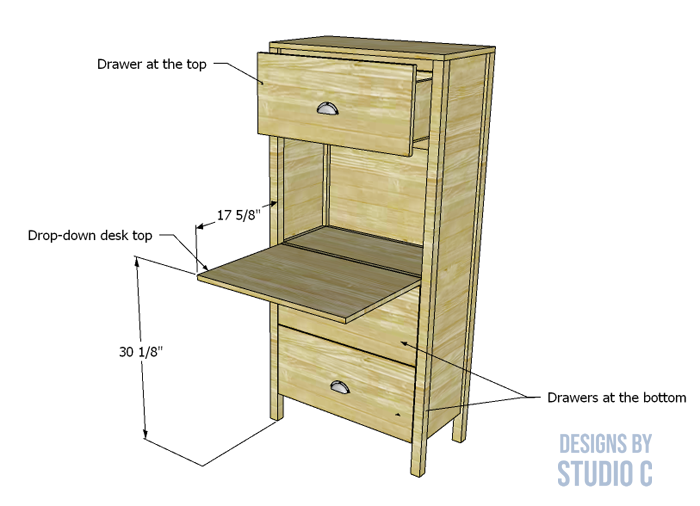
Materials:
- 1-1/4” pocket hole screws
- 3/4″ brad nails
- 2” brad nails
- 1-1/2” screws
- 3 sets of 10” drawer slides (<–affiliate link!)
- Edge banding, optional
- Drop-down hardware (<– affiliate link!)
- 1 – 24” piano hinge
- Four cabinet knobs or pulls
- Sandpaper (80, 120, 220 grits)
- Finishing supplies (primer and paint or stain and sealer)
Lumber:
- 4 – 1×2 at 8’
- 1 – 1×4 at 8’
- 3 – 1×8 at 8’
- 4 – 2×2 at 6’
- 1 – 4’ x 8’ sheet of 1/4” plywood
- 1 – 4’ x 8’ sheet of 3/4″ plywood
Cut List:
- 4 – 2×2 at 59-1/4” – Legs
- 4 – 1×2 at 11” – Side Framing
- 6 – 1×4 at 11” – Side Framing
- 2 – 1/4″ plywood at 11” x 54-1/4” – Side Panels
- 3 – 1×2 at 25” – Back Framing
- 1 – 1/4″ plywood at 25” x 54-1/4” – Back Panel
- 5 – 1×2 at 25” – Front Stretchers
- 1 – 3/4″ plywood at 11” x 25” – Drop-Down Shelf
- 1 – 3/4″ plywood at 14” x 28” – Top
- 6 – 1×8 at 12” – Drawer Box Sides
- 6 – 1×8 at 22-1/2” – Drawer Box Front & Back
- 3 – 1/4″ plywood at 12” x 24” – Drawer Box Bottom
- 1 – 3/4″ plywood at 11-1/4” x 24-3/4” – Upper Drawer Front
- 2 – 3/4″ plywood at 12” x 24-3/4” – Lower Drawer Fronts
- 1 – 3/4″ plywood at 17-1/2” x 24-3/4” – Drop Down Surface
Notes About the Project:
- Edge banding will be applied to the exposed edges of the plywood before assembly
- Sand all pieces first before putting anything together – it makes finishing easier!
- The drawer boxes can be cut from 3/4” plywood instead of 1×8 lumber if it’s more economical
- As a decorative option, the sides can be covered with decorative paper or peel-and-stick wallpaper!
Step One
Cut the pieces for the legs and the side framing. With the pocket hole jig set for ¾” material, drill pocket holes in each end of the 1×2 and 1×4 framing pieces. Secure the framing pieces to the legs as shown using glue and 1-1/4” pocket hole screws. The back faces of the framing will be flush with the inside faces of the legs.

Step Two
Cut the pieces for the side panels. Secure to the outside of the framing pieces using glue and 3/4” brad nails.
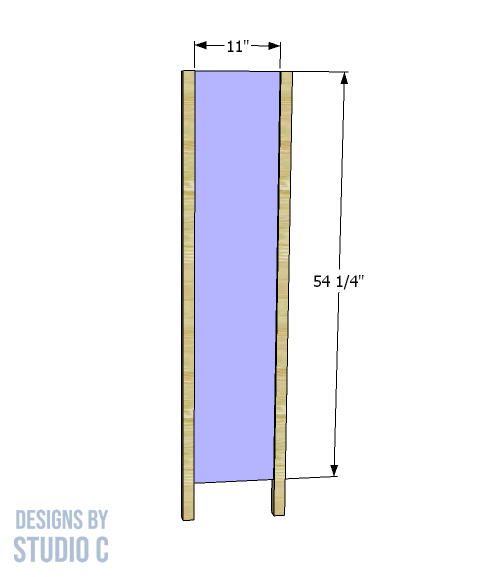
Step Three
Cut the pieces for the back framing and drill pocket holes in each end. Secure the framing pieces to the legs, locating them 1/4” back from the back faces of the legs, using glue and 1-1/4” pocket hole screws.

Step Four
Cut the piece for the back panel. Secure the panel on the outside of the back framing pieces using glue and 3/4” brad nails.

Step Five
Cut the pieces for the front framing and drill pocket holes in each end. Secure the framing pieces to the legs, locating them 3/4” back from the back faces of the legs, using glue and 1-1/4” pocket hole screws.
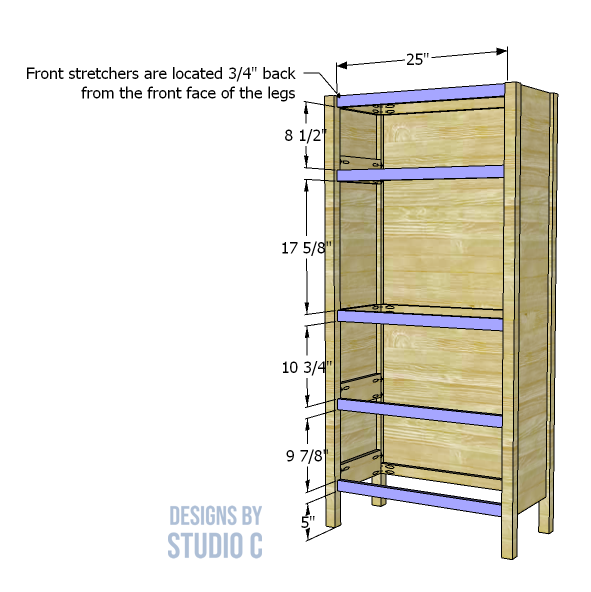
Step Six
Cut the piece for the drop-down shelf and drill pocket holes in all four edges. Position the piece in the framing of the cabinet as shown in the drawing, with the top face flush with the top face of the framing, and secure using glue and 1-1/4” pocket hole screws.

Step Seven
Cut the piece for the top. There is no overhang, so position the top piece on the framing and legs, then secure in place using glue and 2” brad nails.

Step Eight
Cut the pieces for the drawer boxes. Drill pocket holes in each end of the longer pieces and assemble the drawer boxes using glue and 1-1/4” pocket hole screws.
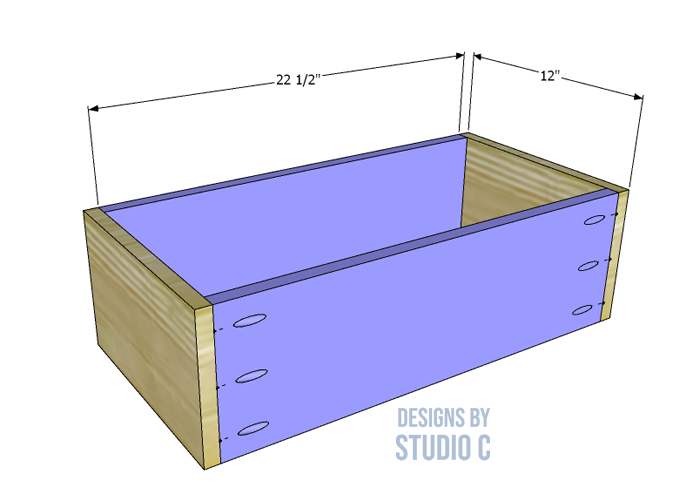
Step Nine
Cut the pieces for the drawer bottoms. Secure to the bottom of the drawer box frames using glue and 3/4” brad nails.
Install the drawer slides according to the manufacturer’s installation instructions. This guide on how to install drawer slides will come in handy!

Step Ten
Cut the pieces for the drawer fronts. Starting with the upper drawer front, determine the position of the drawer pull and drill the holes. Clamp the drawer front to the upper front framing piece, lower edges flush, and drive screws through the holes for the drawer pull into the drawer box behind it. This is to temporarily secure the drawer front on the drawer box. Open the drawer and secure the drawer front from the inside of the drawer box using 1-1/2” screws. Remove the screws from the front (in the holes for the drawer pull) and drill the holes all the way through the front of the drawer box. Install the drawer pull. This tutorial on how to install drawer fronts will go in depth with photos!
For the lower drawer fronts, clamp the bottom drawer front to the lowest framing piece and follow the same steps as above to secure the drawer front.
For the next drawer front, place a 1/8” shim on top of the lowest drawer front, then position this one on top. Follow the same steps to install the drawer front.

Step Eleven
Cut the piece for the drop-down surface. Install the piano hinge on the edge of the surface and the corresponding front framing piece so that it is “pinched” between them when the surface is opened flat. The surface piece may have to be trimmed a bit to allow for clearance.
Install the drop-down hardware according to the manufacturer’s instructions. This hardware fastens to the outer edges of the surface when opened flat as well as to the sides of the cabinet or legs. An additional small spacer may have to be added to the side framing so that the hardware can secure to it.
If there are questions about this step or if it is unclear, let me know and I’ll do my best to walk you through it!

Finish the cabinet as desired.
This is a great piece for any room, especially an entryway! Have questions about the DIY plans to build a Valerie storage cabinet? Leave a comment below!




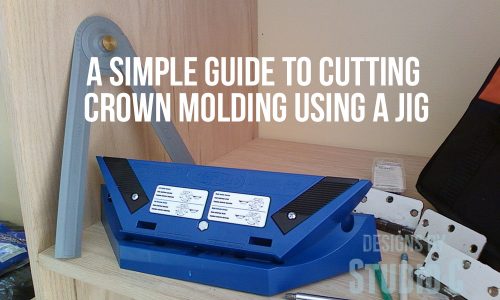


Comments are closed.